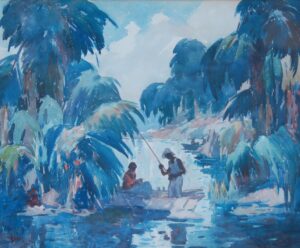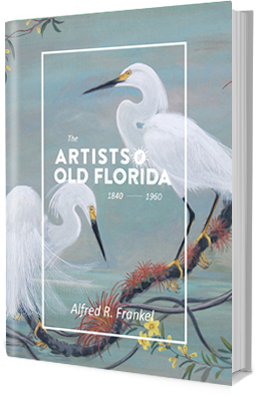George Pearce Ennis, Sarasota. Watercolor, 20 by 24 inches, signed lower left, Ennis.
George Pearse Ennis was president of the American Watercolor Society, secretary of the New York Watercolor Society, a Director at the Grand Central School of Art in New York City, and a leading exponent of modern watercolor painting who wrote the watercolor section of a 1920-30’s edition of the Encyclopedia Britannica.
Ennis wintered in Florida. When the Florida Federation of Art held its first annual convention in Gainesville in March 1928, George Ennis was on the jury of selection. His friend Emmaline Buchholtz was president of the Federation.
On April 27, 1929, Ennis penned the following letter on American Watercolor Society stationary, New York City: “Dear Mrs. Buchholtz, In this letter I will try and tell you how well your work looks and how great a promise it gives. Painting is largely a thing of the mind and thought, imagination is vitally important, what we see outwardly with the eyes must be considered, selected, the dross thrown out and with a large quantity of excitement recast on paper or canvas. Your woodland pictures gave me a feeling of mystery and a sense of romance, which means that you have a solid front to work from….” Ennis then goes on to discuss his work on the Encyclopedia and the opening of his exhibit in Syracuse. He then continues, “I’ll write again soon. Sincerely yours, Geo. Ennis. Regards to Fritz and the children.” *
Ennis’ friendship with Buchholtz led to a series of exhibits of his watercolors from the Florida State College for Women in Tallahassee in February 1929 to the Tampa Art Institute in March, the Orlando Art Association at the Orlando Chamber of Commerce in April and to the Art Club of St. Petersburg for Christmas.
Eve Alsman Fuller, art critic for the St. Petersburg Times, three times president of the Florida Federation of Art and director of the WPA Florida Art Project, commented on Ennis’ exhibit at the Art Club of St. Petersburg, “There is a fresh, clean-cut vigor and youth about every painting that I have ever seen by George Pearse Ennis, whether oil or watercolor. Here is a man who seems to come to his easel with the thought of placing there on a pleasant, simple impression of what he feels and sees. He employs no artifice, and the results are always remarkably delightful and whole some. A scene painted on the Gulf Coast, near Cedar Key…caught some of the sunlight and color which Ennis believes will eventually draw many artists to the state.” (St. Petersburg Times, December 15, 1929)
 At the Royat Hotel lounge, St. Petersburg. Left to right, George Pearse Ennis, Mrs. S. Peter Wagner, Eve Alsman Fuller, Mrs. Ennis, Mr. Wagner. St. Petersburg Times, January 10, 1932.
At the Royat Hotel lounge, St. Petersburg. Left to right, George Pearse Ennis, Mrs. S. Peter Wagner, Eve Alsman Fuller, Mrs. Ennis, Mr. Wagner. St. Petersburg Times, January 10, 1932.
In October of 1931 he became the head of the art faculty at the Ringling School of Art and that year, along with Theodore Coe of Tampa and Leno Lazzari of Rome, Italy, served on the jury of selection for the Florida Federation of Art annual traveling exhibition. Ennis spoke to the Art Club of St. Petersburg in January of 1932, “There is an intense and interesting form of life and color in Florida. In many ways, it is similar to the extreme north where everything seems so alive and so tremendous. The luxuriant foliage of this state, especially, offers much for the artist. Take Florida palms, the palmetto, the sea grape, all these offer a wide variety of design and ideas. There is abundant material in Florida which has never been put on canvas or paper. There is a great deal that artists have never dreamed of.”
Florida Governor Carlton asked Ennis to serve in an advisory capacity to the committee choosing art for the Florida exhibit at the Century of Progress in Chicago. Ennis proposed to depict Florida history from statehood to present day.
The New York Times commented on Ennis’ work at the Babcock Galleries, “One of the most striking features of Ennis’ tropical studies is his intelligent use of white; the glistening trunks of certain species of the palm, the white expanse of water under strong sun, the burnished white of the sun itself, these are elements seldom grasped by the color enamored artist.”
On his way to the Adirondacks for vacation, Ennis died in a car accident near Utica, New York, August 28, 1936. A memorial exhibit was held in New York City at the Grand Central Art Galleries on Fifth Avenue. The exhibition included many Florida landscapes. Ennis was also known for his stained-glass windows. His three Memorial Victory Windows at the United States Military Academy, West Point, are a fitting remembrance.
Born: July 21, 1881, St. Louis, Missouri. Died: August 28, 1936, Utica, New York, after a car accident. Membership: Florida Federation of Art; Allied Artists of America; American Watercolor Society, president; New York Watercolor Society; Architectural League of New York; National Academy of Design; Salmagundi Club, Shaw prize, 1922; director Eastport School of Art, Eastport, Maine. Exhibits: Salmagundi Club, New York City, 1923, Shaw Prize, Buckmans Head, The Northern Passage; Tampa Art Institute, March 1928, exhibit of paintings from Grand Central School of Art, NYC; Florida State College for Women, February 1929, Hunting in Florida, Our Boatman, Water Oaks and Moss and Fishing for Bass (all painted at Luna Plantation near Tallahassee); Tampa Museum of Art, March-April 1929, watercolors, North Coast Inlet, Ship Workers, Petty Harbor, Our Boatman, Water Oaks and Moss, The Market-Nassau, Returning from the Fields, Spanish Ships, Grand Bank Fisherman, Free Wind, The Hunting Party, The Talc Mine, Lake at Alt Aussi, The Lobster Man, Making Ready-St. Pierrie, Off the Banks, French Village-St. Pierrie, Tyrolean Village, Fishing for Bass, Hunting in Florida and Drifting In; Orlando Art Association at Orlando Chamber of Commerce, April 1929; Jacksonville Woman’s Club, Fine Art Society of Jacksonville, May 1929, one man exhibit, Grand Banks Fisherman, Hunting Party at Klachan, Lake at Altaossee, Returning From the Fields, Old French Ship, Off for the Banks, North Coast Inlet, Maddock’s Cove, Making Ready, Sketching, St. Joe Harbor, Petty Harbor, Tyrolian Village, Water Oaks, Our Boatman, Hunting in Florida; Art Club of St. Petersburg, December 1929, watercolors including Glacial Rocks and Gulf Coast near Cedar Key; Art Club of St. Petersburg, January 7-21, 1931, Hunting in Florida, Sunlit Houses, Opal Seas, Our Boatman, Florida, Desolation Point, Palms and Native Life, The Keys, The Gulf; Tampa Art Institute, at Municipal Auditorium, Ringling School of Art Faculty, December 1931, The Fish Woman and Driven Ashore; Florida Federation of Art, committee of selection for 1932 annual circuit; Ringling Museum of Art, February, 1932, 1st Contemporary Art Exhibit, faculty, Ringling School of Art; Studio Club, Rollins College, watercolors; Babcock Galleries, New York City, March 1932, twenty Florida scenes; Florida Federation of Art, 19th Annual, Miami Beach, December 1945, etching. Works: Stained glass windows, New York Athletic Club; Church of All Nations, New York City; New York Military Academy, Victory Windows; Unitarian Church, Eastport, Maine; First Baptist Church, Jamaica, Long Island; Presbyterian Church, Cornwall, New York; Watercolors at the Metropolitan Museum, New York; Museum of Fine Arts, Boston, Art Institute of Chicago and Washington, D.C.
Letter provided by Gainesville, Florida artist Lenard Weinbaum.




